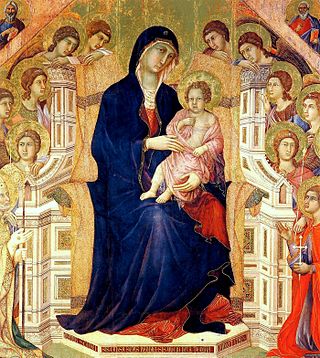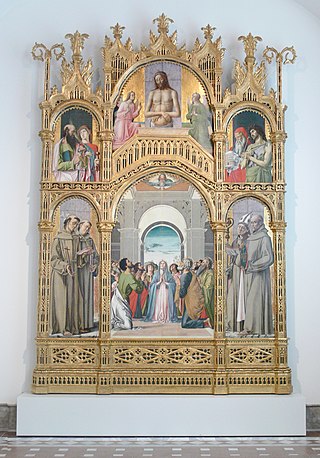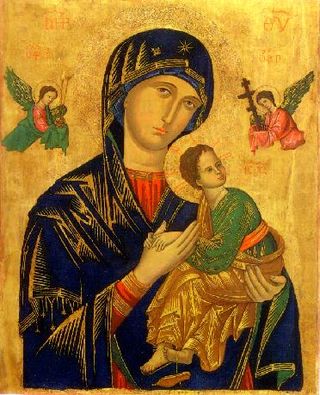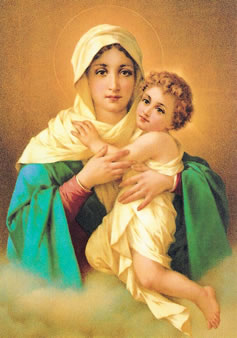
Giuseppe Peano was an Italian mathematician and glottologist. The author of over 200 books and papers, he was a founder of mathematical logic and set theory, to which he contributed much notation. The standard axiomatization of the natural numbers is named the Peano axioms in his honor. As part of this effort, he made key contributions to the modern rigorous and systematic treatment of the method of mathematical induction. He spent most of his career teaching mathematics at the University of Turin. He also wrote an international auxiliary language, Latino sine flexione, which is a simplified version of Classical Latin. Most of his books and papers are in Latino sine flexione, while others are in Italian.

Duccio di Buoninsegna, commonly known as just Duccio, was an Italian painter active in Siena, Tuscany, in the late 13th and early 14th century. He was hired throughout his life to complete many important works in government and religious buildings around Italy. Duccio is considered one of the greatest Italian painters of the Middle Ages, and is credited with creating the painting styles of Trecento and the Sienese school. He also contributed significantly to the Sienese Gothic style.

Alvise or Luigi Vivarini (1442/1453–1503/1505) was an Italian painter, the leading Venetian artist before Giovanni Bellini. Like Bellini, he was part of a dynasty of painters. His father was Antonio Vivarini and his uncle, with whom he may have trained, was Bartolomeo Vivarini. Another uncle, on his mother's side, was the artist known as Giovanni d'Alemagna, who worked with his brother-in-law Antonio. Alvise may have trained Jacopo de' Barbari.

Sant'Andrea della Valle is a minor basilica in the rione of Sant'Eustachio of the city of Rome, Italy. The basilica is the general seat for the religious order of the Theatines. It is located at Piazza Vidoni, at the intersection of Corso Vittorio Emanuele and Corso Rinascimento.

Marcantonio Franceschini was an Italian painter of the Baroque period, active mostly in his native Bologna. He was the father and teacher of Giacomo Franceschini.

Mater Admirabilis is a fresco depicting the Virgin Mary, in the monastery of the Trinità dei Monti, in Rome. It was painted in 1844 by a young French artist, Pauline Perdrau, and has been associated with several miracles. October 20 is the Feast of Mater Admirabilis in the Roman Catholic Church, as observed by the Society of the Sacred Heart.

The Madonna della Seggiola or The Madonna della Sedia is an oil on panel Madonna painting by the High Italian Renaissance artist Raphael, executed c. 1513–1514, and housed at the Palazzo Pitti Collection in Florence, Italy. Although there is documentation on its arrival to its current location, Palazzo Pitti, it is still unknown who commissioned the painting; however, it has been in the Medici family since the 16th century.

Antonio Balestra was an Italian painter of the Rococo period.

Luigi Miradori was an Italian painter of the Baroque period, active mainly in Cremona.

Italian Renaissance painting is the painting of the period beginning in the late 13th century and flourishing from the early 15th to late 16th centuries, occurring in the Italian Peninsula, which was at that time divided into many political states, some independent but others controlled by external powers. The painters of Renaissance Italy, although often attached to particular courts and with loyalties to particular towns, nonetheless wandered the length and breadth of Italy, often occupying a diplomatic status and disseminating artistic and philosophical ideas.

Girolamo Donnini was an Italian painter of the Baroque period, born in the town of Correggio, Emilia-Romagna. He was a pupil of the painters Francesco Stringa in Modena, and then of Giovanni Gioseffo dal Sole in Bologna, then traveled to Forlì to work with Carlo Cignani.

The Eleusa is a type of depiction of the Virgin Mary in icons in which the Christ Child is nestled against her cheek. In the Western Church the type is often known as the Virgin of Tenderness.

Mary has been one of the major subjects of Western Art for centuries. There is an enormous quantity of Marian art in the Catholic Church, covering both devotional subjects such as the Virgin and Child and a range of narrative subjects from the Life of the Virgin, often arranged in cycles. Most medieval painters, and from the Reformation to about 1800 most from Catholic countries, have produced works, including old masters such as Michelangelo and Botticelli.

Luigi Crosio (1835–1915) was an Italian painter who lived and worked in Turin, Italy. A fine draftsman and painter, Crosio's work was much sought after for lithographic reproduction.

The Madonna and Child with Saints Luke and Catherine of Alexandria, also known simply as Holy Conversation, is a painting by the Italian Renaissance master Titian. It is one of his several versions of the canonical image of the Madonna and Child.

Golden Madonna is a 1949 British-Italian drama film directed by Luigi Carpentieri and Ladislao Vajda and starring Phyllis Calvert, Tullio Carminati and Michael Rennie. It was considered a lost film and was on the BFI 75 Most Wanted list, until a copy was loaned to the British Film Institute by Cohen Media. Filmed on location, a group of original negatives and contact prints taken by Francis Goodman are in the possession of London's National Portrait Gallery.

Ottaviano Nelli (1375–1444?) was an Italian painter of the early Quattrocento. Nelli primarily painted frescoes, but also panel paintings. He had several pupils and two painters were influenced by him.

Pompeo Marino Molmenti was an Italian painter.
Santa Chiara also known as the Santuario Madonna della Misericordia or Sanctuary of the Mater Misericordia is a Baroque-style Roman Catholic church located in via Santa Chiara #28 in Rimini, Italy. The church is best known for housing a venerated icon of the Madonna that has putatively moved its eyes for many believers.

Francesco Zanella was an Italian painter, active in Padua and painting in a Baroque style.



















